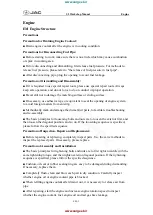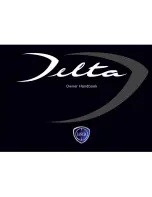
WARNING!
•
Anti-lock system (ABS) cannot prevent the natu-
ral laws of physics from acting on the vehicle, nor
can it increase braking or steering efficiency be-
yond that afforded by the condition of the vehicle
brakes and tires or the traction afforded.
•
The ABS cannot prevent accidents, including
those resulting from excessive speed in turns,
following another vehicle too closely, or hydro-
planing. Only a safe, attentive, and skillful driver
can prevent accidents.
•
The capabilities of an ABS equipped vehicle must
never be exploited in a reckless or dangerous
manner which could jeopardize the user’s safety
or the safety of others.
The ABS light monitors the Anti-Lock Brake
System. The light will come on when the
ignition switch is turned to the ON position
and may stay on for as long as four seconds.
If the ABS light remains on or comes on while driving, it
indicates that the Anti-Lock portion of the brake system
is not functioning and that service is required. However,
the conventional brake system will continue to operate
normally if the BRAKE warning light is not on.
If the ABS light is on, the brake system should be serviced
as soon as possible to restore the benefits of Anti-Lock
brakes. If the ABS light does not come on when the
Ignition switch is turned to the ON position, have the
bulb repaired as soon as possible.
If both the Brake Warning Light and the ABS Light
remain on, the Anti-Lock brakes (ABS) and Electronic
Brake Force Distribution (EBD) systems are not function-
ing. Immediate repair to the ABS system is required.
When the vehicle is driven over 7 mph (11 km/h), you
may also hear a slight clicking sound as well as some
related motor noises. These noises are the system per-
forming its self check cycle to ensure that the ABS system
is working properly. This self check occurs each time the
vehicle is started and accelerated past 7 mph (11 km/h).
STARTING AND OPERATING
221
5
Summary of Contents for 2007 Caliber
Page 2: ......
Page 5: ...INTRODUCTION 5 1...
Page 64: ......
Page 89: ...UNDERSTANDING THE FEATURES OF YOUR VEHICLE 89 3...
Page 90: ...90 UNDERSTANDING THE FEATURES OF YOUR VEHICLE...
Page 91: ...UNDERSTANDING THE FEATURES OF YOUR VEHICLE 91 3...
Page 129: ...Removing Flashlight Three Press Switch UNDERSTANDING THE FEATURES OF YOUR VEHICLE 129 3...
Page 141: ...INSTRUMENT PANEL FEATURES UNDERSTANDING YOUR INSTRUMENT PANEL 141 4...
Page 142: ...INSTRUMENT CLUSTER BASE 142 UNDERSTANDING YOUR INSTRUMENT PANEL...
Page 143: ...INSTRUMENT CLUSTER PREMIUM UNDERSTANDING YOUR INSTRUMENT PANEL 143 4...
Page 203: ...Operating Tips UNDERSTANDING YOUR INSTRUMENT PANEL 203 4...
Page 232: ...232 STARTING AND OPERATING...
Page 279: ...ENGINE COMPARTMENT GASOLINE ENGINES MAINTAINING YOUR VEHICLE 279 7...
Page 345: ...INDEX 10...
Page 360: ...NOTES...
















































